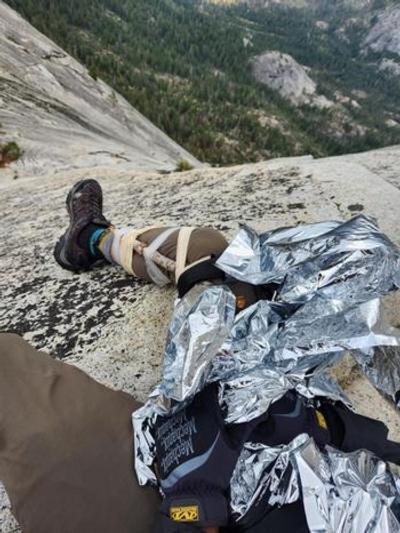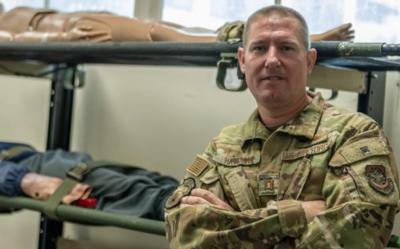Injured Climber Airlifted to Local Hospital
U.S. Air Force Instructor Pilot Captain Joshua Haveman has been recognized for his contribution to the rescue of an injured hiker in California’s Yosemite National Park.

According to representatives of Fairfield, California’s Travis Air Force Base, Captain Haveman, while negotiating the final stretch of a 02 September summiting of the park’s famed Half Dome—an 8,800-foot quartz monzonite batholith named for its distinct morphology—witnessed one of his fellow-adventurers suffer a sixty-to-eighty-foot fall onto a small ledge some eight-thousand-feet above the Yosemite Valley floor.
To assist hikers attempting to summit Half Dome via the peak’s non-sheer aspect, the Park Service has installed a cable-suspension system by which innumerable weekend-warriors have been spared impromptu high-speed descents down the formation’s slick granite ramparts.
In the moments preceding his donning of the hero’s mantle, Haveman, an Instructor Pilot actively serving in the Air Force’s 60th Air Evacuation Squadron, looked on as his fellow hikers rushed to escape the high-winds and hail by which the Yosemite Valley was wracked on 02 September.
Perceiving an accident was likely, Haveman abandoned his pursuit of leisure, pulled a medical kit from his day-pack, and started toward the throng of retreating humanity. Moments later, he watched the hiker fall.
Observing the victim’s legs had been injured, Haveman left the permanent cable barriers with which Half Dome is festooned and made his way toward the fallen hiker, collecting as many sticks as he could lay hands on along the way.
Upon reaching the victim, Haveman fashioned a makeshift splint and secured it, by means of bandages taken from his medical kit, to the injured individual’s lower-leg. Haveman then covered the victim with his coat and instructed witnesses on the mountain to contact authorities.

A short time later, a Park Ranger arrived, helped the injured hiker down the cable system, and administered care for shock. A second Park Ranger arrived with more comprehensive medical supplies, and the victim’s limb was stabilized with a proper emergency splint.
As the weather on the mountain improved, bystanders helped put together a pulley-system by which the injured hiker was lowered the last thirty-feet to the ground.
The crew of an arriving air-ambulance helicopter took charge of the victim and, in short order, air-lifted him to a local hospital.
“I wasn’t sure a helicopter would be able to land with the winds being as strong as they were,” Haveman remarked, “so we were preparing to carry him ten or 12 hours down with a six-man litter. Apparently, it was this pilot’s first day on the job, and he was amazing. It took him about 15-minutes, but he was able to sit the chopper down and we were able to get the patient loaded and breathe a sigh of relief.”

In a subsequent news-release, a Travis Air Force Base spokesman referred to Haveman an “everyday hero” who demonstrated “extraordinary bravery and resourcefulness during a perilous rescue.”
The spokesman went on to state Haveman, owing to the exigencies of federal investigative procedures, would not be immediately available for interview.
Since 2018, three people have lost their lives attempting to summit Half Dome. On 27 July 1985, five hikers were struck by lightning on the mountain—two died.
By way of interesting aside, Half Dome—in addition to featuring prominently in the logo of outdoor-outfitter The North Face and on the obverse of the 2005 California State quarter-dollar coin—serves as the backdrop for Jack London’s 1900 short-story Dutch Courage.
 ANN's Daily Aero-Term (05.29.25): Terminal Radar Service Area
ANN's Daily Aero-Term (05.29.25): Terminal Radar Service Area ANN's Daily Aero-Term (05.30.25): Very High Frequency (VHF)
ANN's Daily Aero-Term (05.30.25): Very High Frequency (VHF) Aero-News: Quote of the Day (05.30.25)
Aero-News: Quote of the Day (05.30.25) Airborne 05.23.25: Global 8000, Qatar B747 Accepted, Aviation Merit Badge
Airborne 05.23.25: Global 8000, Qatar B747 Accepted, Aviation Merit Badge ANN's Daily Aero-Linx (05.30.25)
ANN's Daily Aero-Linx (05.30.25)





